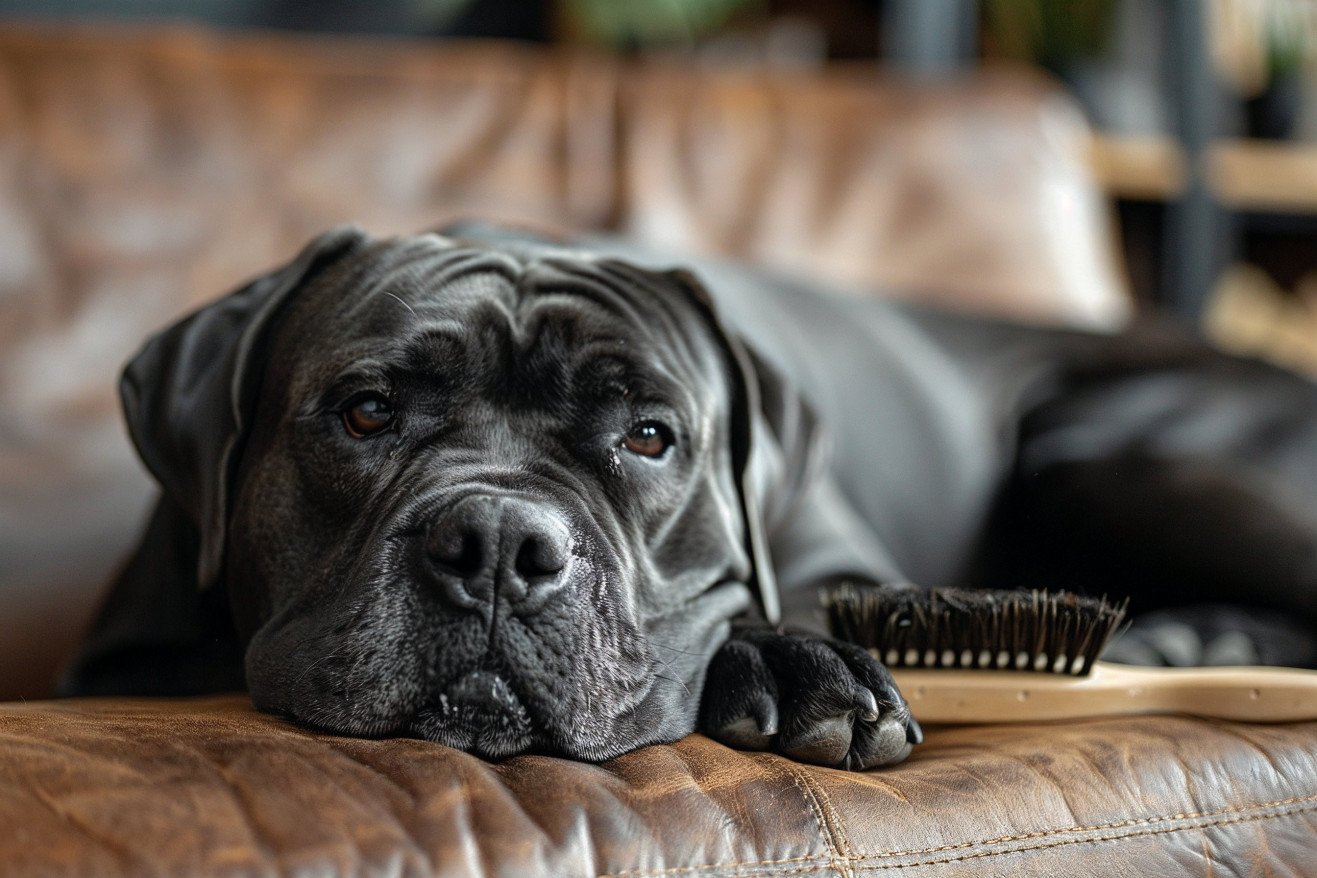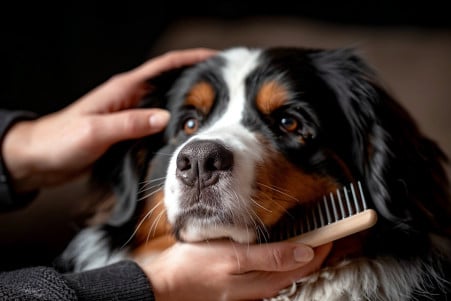Do Cane Corsos Shed? Understanding Your Dog’s Shedding Patterns
27 February 2024 • Updated 27 February 2024

The Cane Corso’s regal appearance comes with a coat that requires a bit of work to maintain. Cane Corsos shed a low to moderate amount because of their short, coarse double coat. Shedding is constant throughout the year but may increase slightly with the changing seasons. Shedding can be controlled with regular brushing, but Cane Corsos are not hypoallergenic.
This article covers everything you need to know about the shedding of Cane Corsos, including information from vets, genetic research, and practical tips on grooming. This combination of sources will help you understand the breed’s coat care needs, when you can expect shedding to be at its worst, and the genetic reasons why Cane Corsos shed.
After reading this article, you’ll have all the information you need to keep your Cane Corso looking its best.
Do Cane Corsos shed?
Shedding of Cane Corsos
The Cane Corso, a breed known for its regal appearance and strong body, has a low to moderate level of shedding that is impacted by a number of factors. Health issues, diet, and how often the dog is groomed all play a big role in how much the dog will shed. The breed also has two shedding seasons, spring and fall, when the coat is adjusting to the new temperatures.
According to Vetnique Labs, a dog’s coat is a good indicator of a dog’s overall health, and internal problems like hormonal imbalances or organ issues can lead to excessive shedding. This is why it’s important to keep an eye out for excessive shedding, as it can be a sign of a number of health issues including thyroid problems and Cushing’s disease.
Diet is also important, as a dog that is fed a well-balanced diet that includes important vitamins and omega fatty acids will have a healthier coat, according to PetMD. Grooming is also important, and using a hypoallergenic brush and keeping up with regular grooming will help manage shedding and keep the skin healthy.
By keeping up with these things, Cane Corso owners can work to keep shedding to a minimum, and it can be something that is easily managed in their pets.
How to Deal With Shedding in Cane Corsos
To stay ahead of your Cane Corso’s shedding, regular grooming is a must. iHeartDogs recommends brushing your Cane Corso once or twice a week with a firm bristle brush or a rubber grooming mitt, which is especially important for shedding management. Not only does this help to remove dead hair, but it also helps to spread skin oils, keeping their coat looking and feeling healthy.
In addition to brushing, another important part of shedding management is bathing your Cane Corso. Paw Planning recommends bathing your Cane Corso every 6 to 12 weeks using natural and organic shampoos with a neutral pH to help maintain skin health. You may need to bathe them more often during the shedding season to help keep the loose hair under control.
Cane Corso Barcelona stresses the importance of starting grooming training early with treats and commands, which can help make grooming a positive experience for both you and your dog.
Expect shedding to increase during the spring and fall. By increasing the number of times you brush your dog during these times, you can help minimize the amount of hair that ends up in your home. That said, a well-groomed Cane Corso is a happier and healthier one, so make sure you stay on top of their grooming needs throughout their shedding cycles.
Genetics of Cane Corso Shedding
As with many other traits, the amount of shedding a Cane Corso does is determined by genetics. Scientists have even pinpointed specific genes that play a role in how much a dog will shed.
One of the most important of these is the MC5R gene, which has been shown to impact sebum production in hair follicles. Not only does the MC5R gene have a variant that is associated with increased shedding, but according to Genomia, dogs with two copies of the G variant of the MC5R gene are especially prone to shedding.
Meanwhile, the RSPO2 gene has been shown to impact hair quality and when combined with the MC5R gene, it can give a more complete picture of a dog’s likelihood to shed.
Compared to other breeds, the amount of shedding that can be expected from Cane Corsos may be harder to predict based on genetics alone, especially if genetic testing isn’t done, since they don’t have the furnishings (moustache and eyebrows) that are commonly associated with low-shedding dogs. According to Animal Genetics, the shedding SD locus and furnishings F locus genes work together to determine a dog’s coat maintenance needs.
While this information is interesting, it’s also practical. Breeders can use genetic tests for the MC5R and RSPO2 genes to determine how much a dog is likely to shed and make breeding decisions based on that information.
This could lead to the ability to produce puppies that are more likely to have the shedding characteristics that people are looking for, which can vary widely from one potential dog owner to another. Knowing that genetics play a role in shedding also underscores the importance of taking a proactive approach to maintaining a dog’s coat through healthcare and nutrition.
Feeding Your Cane Corso for a Healthy Coat
A shiny coat is often a sign of a well-fed Cane Corso. High-quality, AAFCO-approved diets have been shown to reduce shedding because they ensure that dogs get the nutrients they need to maintain a healthy coat. A study by PetMD noted that obesity, hip and elbow dysplasia, and bloat with gastric dilatation-volvulus, all of which Cane Corsos are prone to, can impact their coat and shedding.
In addition to making sure you’re feeding your dog the right food, joint supplements and probiotics can help ensure that your dog’s digestive system is healthy, which can impact the health of their skin and coat.
Regular vet visits are also important to make sure that your dog doesn’t have any hormonal imbalances or metabolic disorders that could lead to excessive shedding. By making sure your Cane Corso eats a healthy diet and gets regular vet care, you can keep shedding to a natural, healthy minimum and help ensure that your dog’s coat looks its best.
How to Manage Shedding in Your Home
One of the most important things you can do to manage shedding in your home is to create an environment that works with your Cane Corso’s natural shedding tendencies. For example, according to PetsRadar, investing in a pet hair-specific vacuum cleaner can make a big difference in how much hair you find around your home.
You can also select furniture with washable covers or that is made from materials that don’t attract dog hair, like leather or closely knit fabrics, to minimize the impact of shedding.
In addition, exercise and outdoor time are important for keeping your Cane Corso’s stress levels in check, which in turn can impact how much they shed. Stress can lead to increased shedding, so make sure you are taking your dog for regular walks and playtime to keep their stress levels low, according to The Village Vets.
Making sure these activities are part of your daily routine will help you keep your dog happy and your home clean.
Finally, to make sure you are managing shedding in a way that works with your lifestyle, set up a regular grooming routine and stick to it. Regular grooming sessions, especially during shedding seasons, can help you keep the amount of hair in your home to a minimum. By making these things part of your regular routine, you can enjoy your time with your Cane Corso without the stress of dealing with excessive shedding.
Embracing the Shed: A Cane Corso Owner’s Guide to Grooming and Care
As mentioned, the Cane Corso’s regal coat comes with the downside of low to moderate shedding, which means that you’ll need to be prepared to spend time and effort on grooming. Regular brushing and occasional baths with the right kind of shampoo are the basic grooming skills you’ll need to know to deal with this shedding.
That said, don’t forget the importance of healthcare and nutrition; make sure you’re feeding your dog a high-quality diet and taking them to the vet regularly to ensure that their coat stays healthy and that their shedding is kept to a minimum.
While the MC5R and RSPO2 genes play a role in determining a Cane Corso’s coat type and shedding, it’s the daily grooming that will really help you keep shedding at bay. By accepting and learning to work with your Cane Corso’s shedding and making sure to take care of it properly, you’ll be able to keep your home cleaner and your bond with your dog stronger.
Owning a Cane Corso is a wonderful experience that goes beyond the inconvenience of having to deal with dog hair tumbleweeds. With regular grooming and care, the benefits of love, loyalty, and protection that these majestic animals provide will far outweigh the minimal effort it takes to manage their shedding.


